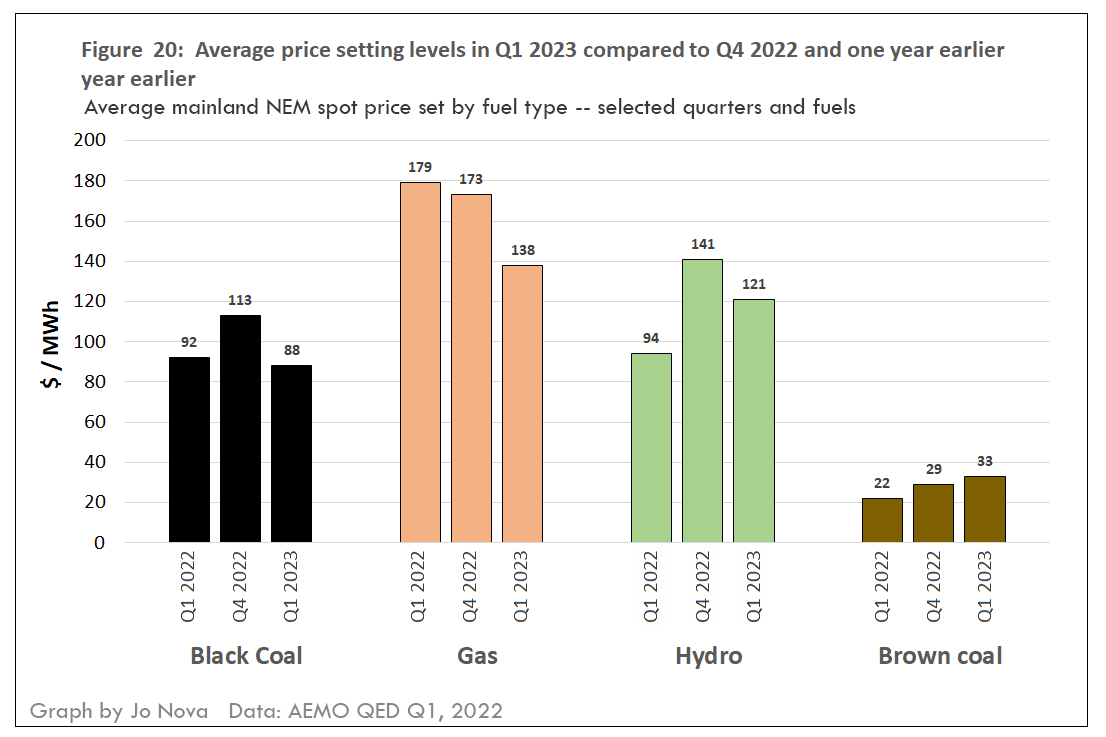By Jo Nova
Don’t mention brown coal?
Last quarter I reported that the Australian Energy Market Operators (AEMO) had strangely “forgotten” to list the brown coal prices in its quarterly report, despite it being the second largest energy source in our national electricity market.
Other quarters, often they would include a graph comparing the average winning bids of all the major fuel types — a graph that surely is essential in these inflationary times where our electricity prices are setting record highs, rising by 25% this month, and we have a national debate on our energy crisis.
In the next quarterly report the AEMO did list the average “winning bids” of brown coal but didn’t do the comparison graph, so I’ve done it for them. If only they had room in their 68 page report and $450 million dollar budget so Australians can see, at a glance, which fuel source provides the cheapest wholesale generation by far, every quarter, all the time?
Despite all the inflation, the war, and the pandemic, brown coal generators are still making electricity for 3c a KWh. Shouldn’t Australians know that?

Click to enlarge (Or download the larger JPG file)
Compare that to current retail electricity prices in our renewables superstar state South Australia — where the cost varies from 33c to 47c per kilowatt hour.
Brown coal doesn’t “set” the winning bid as often as it used to when it was a larger proportion of our generation mix. Obviously, if it did, we’d have cheaper electricity.
The prices for solar and wind power were the nonsensical minus $24 and minus $41/ MWh. They’re not included because they are not despatchable, and most of the costs of the unreliables are hidden in subsidies. When we spend $20 billion on pumped hydro and transmission lines, those costs, like the batteries and demand schemes should be added to the wind and solar charges. When the rest of the reliable grid has to charge more to cover their costs of sitting around on “standby” — those higher costs should be added to the renewables bill too.
Brown coal is a national asset because it is impervious to international dramas and conflicts. It can’t be shipped far because it has a habit of catching fire on the boat, so there is no international market, instead we have hundreds of years of supply all to ourselves. The more we use, the more black coal and gas we can make billions of dollars with. Instead of being a renewable energy superpower, we could be a cheap energy superpower.
Australia made $124 billion dollars in export revenues from black coal last year
Imagine a world where Australian electricity prices were cheap again and industries moved here from all over the world. With the extra funds Australian families could afford laptops, music lessons, books and adventure camps for every child, or trips to the Whitsundays, Ningaloo, whatever turned them on. Parents might not have to work two jobs. What a life of riches we gave up so easily, with so little thought, because we were badgered and bullied into a futile quest to change the weather?
As it is, here in the Renewable Land, the Australian Labor Party has decided not to even talk about coal in its party platform, despite it being our second largest export industry. President Xi, Larry Fink, the WEF and the UN will be happy.
REFERENCE
The AEMO Quarterly Energy Dynamics (QED) reports